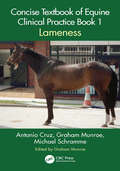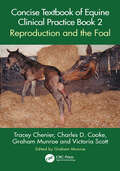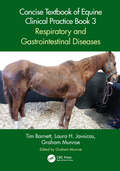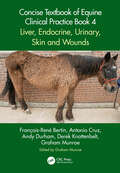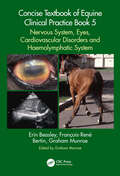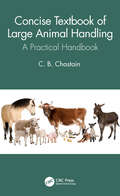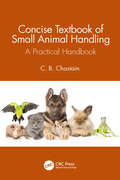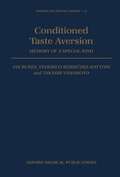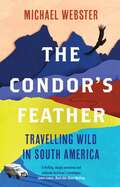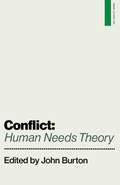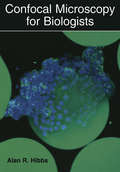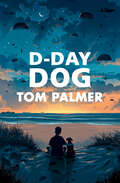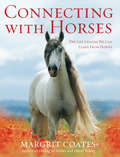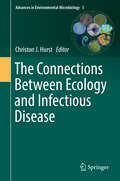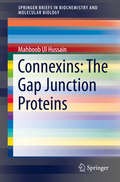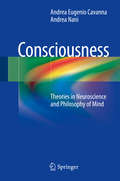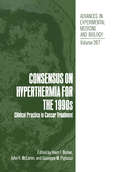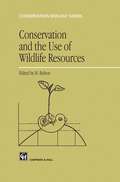- Table View
- List View
Concise Textbook of Equine Clinical Practice Book 1: Lameness
by Antonio Cruz Graham Munroe Michael SchrammeThis concise, practical text covers the essential information veterinary students, new graduates and practitioners need to succeed in equine practice, focussing on lameness. Written for an international readership, the book conveys the core information in an easily digestible, precise form with extensive use of bullet-points, lists, diagrams, protocols and extensive illustration (over 650 full colour, high quality photographs). Part of a five-book series that extracts and updates key information from Munroe’s Equine Surgery, Reproduction and Medicine, Second Edition, the book distils best practice in a logical straightforward clinical-based approach. It details clinical anatomy, physical clinical examination techniques, diagnostic techniques and normal parameters, emphasising the things regularly available to general practitioners with minimal information of advanced techniques. The clinical information is split into anatomy-based sections. Ideal for veterinary students on clinical placements with horses as well as for practitioners needing a quick reference ‘on the ground’, the spiralbound format allows the book to lie open during practice.
Concise Textbook of Equine Clinical Practice Book 1: Lameness
by Antonio Cruz Graham Munroe Michael SchrammeThis concise, practical text covers the essential information veterinary students, new graduates and practitioners need to succeed in equine practice, focussing on lameness. Written for an international readership, the book conveys the core information in an easily digestible, precise form with extensive use of bullet-points, lists, diagrams, protocols and extensive illustration (over 650 full colour, high quality photographs). Part of a five-book series that extracts and updates key information from Munroe’s Equine Surgery, Reproduction and Medicine, Second Edition, the book distils best practice in a logical straightforward clinical-based approach. It details clinical anatomy, physical clinical examination techniques, diagnostic techniques and normal parameters, emphasising the things regularly available to general practitioners with minimal information of advanced techniques. The clinical information is split into anatomy-based sections. Ideal for veterinary students on clinical placements with horses as well as for practitioners needing a quick reference ‘on the ground’, the spiralbound format allows the book to lie open during practice.
Concise Textbook of Equine Clinical Practice Book 2: Reproduction and the Foal
by Tracey Chenier Charles D. Cooke Graham Munroe Victoria ScottThis concise, practical text covers the essential information veterinary students and nurses, new graduates and practitioners need to succeed in equine practice, focussing on reproduction and the foal. Written for an international readership, the book conveys the core information in an easily digestible, precise form with extensive use of bullet-points, lists, diagrams, protocols and extensive illustrations (nearly 200 full colour, high quality photographs). Part of a five-book series that extracts and updates key information from Munroe’s Equine Surgery, Reproduction and Medicine, Second Edition, the book distils best practice in a logical straightforward clinical-based approach. It details clinical anatomy, physical clinical examination techniques, diagnostic techniques and normal parameters, emphasising the things regularly available to general practitioners with minimal information of advanced techniques. The clinical information is split into anatomy-based sections. Ideal for veterinary students and nurses on clinical placements with horses as well as for practitioners needing a quick reference ‘on the ground’.
Concise Textbook of Equine Clinical Practice Book 2: Reproduction and the Foal
by Tracey Chenier Charles D. Cooke Graham Munroe Victoria ScottThis concise, practical text covers the essential information veterinary students and nurses, new graduates and practitioners need to succeed in equine practice, focussing on reproduction and the foal. Written for an international readership, the book conveys the core information in an easily digestible, precise form with extensive use of bullet-points, lists, diagrams, protocols and extensive illustrations (nearly 200 full colour, high quality photographs). Part of a five-book series that extracts and updates key information from Munroe’s Equine Surgery, Reproduction and Medicine, Second Edition, the book distils best practice in a logical straightforward clinical-based approach. It details clinical anatomy, physical clinical examination techniques, diagnostic techniques and normal parameters, emphasising the things regularly available to general practitioners with minimal information of advanced techniques. The clinical information is split into anatomy-based sections. Ideal for veterinary students and nurses on clinical placements with horses as well as for practitioners needing a quick reference ‘on the ground’.
Concise Textbook of Equine Clinical Practice Book 3: Respiratory and Gastrointestinal Diseases
by Tim Barnett Laura H. Javsicas Graham MunroeThis concise, practical text covers the essential information veterinary students and nurses, new graduates, and practitioners need to succeed in equine medicine, focussing on respiratory and gastrointestinal diseases. Written for an international readership, the book conveys the core information in an easily digestible, precise form with extensive use of bullet points, lists, diagrams, protocols, and extensive illustrations (over 300 full-colour, high-quality photographs). Part of a five-book series that extracts and updates key information from Munroe’s Equine Surgery, Reproduction and Medicine, Second Edition, the book distils best practice in a logical straightforward clinically based approach. It details relevant clinical anatomy, physical clinical examination techniques and findings, normal parameters, aetiology/pathophysiology, differential diagnoses, diagnostic techniques, management and treatment, and prognosis. The emphasis is on information tailored to general equine clinicians with just enough on advanced techniques to make the practitioner aware of what is available elsewhere. The respiratory system is split into sections on surgical and medical conditions of the upper and lower respiratory tracts. The gastrointestinal system is divided into the upper tract, including the oral cavity and dentistry, and the lower tract and peritoneal cavity. Ideal for veterinary students and nurses on clinical placements with horses as well as practitioners needing a quick reference ‘on the ground’.
Concise Textbook of Equine Clinical Practice Book 3: Respiratory and Gastrointestinal Diseases
by Tim Barnett Laura H. Javsicas Graham MunroeThis concise, practical text covers the essential information veterinary students and nurses, new graduates, and practitioners need to succeed in equine medicine, focussing on respiratory and gastrointestinal diseases. Written for an international readership, the book conveys the core information in an easily digestible, precise form with extensive use of bullet points, lists, diagrams, protocols, and extensive illustrations (over 300 full-colour, high-quality photographs). Part of a five-book series that extracts and updates key information from Munroe’s Equine Surgery, Reproduction and Medicine, Second Edition, the book distils best practice in a logical straightforward clinically based approach. It details relevant clinical anatomy, physical clinical examination techniques and findings, normal parameters, aetiology/pathophysiology, differential diagnoses, diagnostic techniques, management and treatment, and prognosis. The emphasis is on information tailored to general equine clinicians with just enough on advanced techniques to make the practitioner aware of what is available elsewhere. The respiratory system is split into sections on surgical and medical conditions of the upper and lower respiratory tracts. The gastrointestinal system is divided into the upper tract, including the oral cavity and dentistry, and the lower tract and peritoneal cavity. Ideal for veterinary students and nurses on clinical placements with horses as well as practitioners needing a quick reference ‘on the ground’.
Concise Textbook of Equine Clinical Practice Book 4: Liver, Endocrine, Urinary, Skin and Wounds
by François-René Bertin Antonio Cruz Andy Durham Derek KnottenbeltThis concise, practical text covers the essential information veterinary students need to succeed in equine medicine and surgery, focussing on skin, urinary, liver and endocrine diseases. Written for an international readership, the book conveys the core information in an easily digestible, precise form with extensive use of bullet points, tables, flow charts, diagrams, lists, protocols and extensive illustrations. Part of a five-book series that extracts and updates key information from Munroe’s Equine Surgery, Reproduction and Medicine, Second Edition, the book distils best practice in a logical straightforward clinical-based approach. It details clinical anatomy, physical clinical examination techniques, diagnostic techniques and normal parameters, emphasising the things regularly available to general practitioners with minimal information of advanced techniques. The liver section is divided into clinical evaluation, diagnostic tests, possible causes and treatment. The diagnostic approach to endocrine disease is followed by specific diseases of the thyroid, parathyroid, pituitary gland, equine metabolic syndrome and other miscellaneous disorders. The approach to urinary tract problems includes information on diagnostic tests and imaging, renal diseases,,and diseases of the ureter, bladder and urethra. The approach to skin disease is discussed in detail, including relevant diagnostic tests. Following this, individual skin diseases are covered under the headings of genetic, infectious, immune-mediated, nutritional, endocrine, idiopathic, traumatic and neoplastic causes. Finally, skin wounds, burns and infections of synovial structures are discussed. Ideal for veterinary students and nurses on clinical placements with horses as well as practitioners needing a quick reference ‘on the ground’.
Concise Textbook of Equine Clinical Practice Book 4: Liver, Endocrine, Urinary, Skin and Wounds
by François-René Bertin Antonio Cruz Andy Durham Derek KnottenbeltThis concise, practical text covers the essential information veterinary students need to succeed in equine medicine and surgery, focussing on skin, urinary, liver and endocrine diseases. Written for an international readership, the book conveys the core information in an easily digestible, precise form with extensive use of bullet points, tables, flow charts, diagrams, lists, protocols and extensive illustrations. Part of a five-book series that extracts and updates key information from Munroe’s Equine Surgery, Reproduction and Medicine, Second Edition, the book distils best practice in a logical straightforward clinical-based approach. It details clinical anatomy, physical clinical examination techniques, diagnostic techniques and normal parameters, emphasising the things regularly available to general practitioners with minimal information of advanced techniques. The liver section is divided into clinical evaluation, diagnostic tests, possible causes and treatment. The diagnostic approach to endocrine disease is followed by specific diseases of the thyroid, parathyroid, pituitary gland, equine metabolic syndrome and other miscellaneous disorders. The approach to urinary tract problems includes information on diagnostic tests and imaging, renal diseases,,and diseases of the ureter, bladder and urethra. The approach to skin disease is discussed in detail, including relevant diagnostic tests. Following this, individual skin diseases are covered under the headings of genetic, infectious, immune-mediated, nutritional, endocrine, idiopathic, traumatic and neoplastic causes. Finally, skin wounds, burns and infections of synovial structures are discussed. Ideal for veterinary students and nurses on clinical placements with horses as well as practitioners needing a quick reference ‘on the ground’.
Concise Textbook of Equine Clinical Practice Book 5: Nervous System, Eyes, Cardiovascular Disorders and Haemolymphatic System
by Erin Beasley Graham Munroe François-René BertinThis concise, practical text covers the essential information veterinary students need to succeed in equine medicine and surgery, focusing on the nervous system, eyes, cardiovascular disorders and haemolymphatic systems. Written for an international readership, the book conveys the core information in an easily digestible, precise form with extensive use of bullet points, tables, flow charts, diagrams, lists, protocols and extensive illustrations. Part of a five-book series that extracts and updates key information from Munroe’s Equine Surgery, Reproduction and Medicine, Second Edition, the book distils best practice in a logical straightforward clinical-based approach. It details clinical anatomy, physical clinical examination techniques, diagnostic techniques and normal parameters, emphasising the things regularly available to general practitioners with minimal information of advanced techniques. The nervous system section discusses in detail the neurological exam, mentions relevant diagnostic tests and divides the diseases of the system into congenital, infectious, traumatic, toxin-induced and miscellaneous causes. In the eye section, the relevant anatomy and the examination of the eye are followed by discussion of useful diagnostic tests and procedures. Diseases of the eye are discussed under the headings of congenital/neonatal, neoplastic, infectious and inflammatory disorders, neurological based and parasitic problems. The cardiological examination and relevant diagnostic tests are followed by sections on arrhythmias, congenital and acquired cardiac diseases, pericardial disease and miscellaneous cardiovascular disease. Finally, the haemolymphatic section discusses in detail relevant diagnostic approaches and laboratory aids, followed by sections on anaemia, haemostasis disorders, infections and neoplasia. Ideal for veterinary students and nurses on clinical placements with horses, as well as practitioners needing a quick reference ‘on the ground’.
Concise Textbook of Equine Clinical Practice Book 5: Nervous System, Eyes, Cardiovascular Disorders and Haemolymphatic System
by Erin Beasley Graham Munroe François-René BertinThis concise, practical text covers the essential information veterinary students need to succeed in equine medicine and surgery, focusing on the nervous system, eyes, cardiovascular disorders and haemolymphatic systems. Written for an international readership, the book conveys the core information in an easily digestible, precise form with extensive use of bullet points, tables, flow charts, diagrams, lists, protocols and extensive illustrations. Part of a five-book series that extracts and updates key information from Munroe’s Equine Surgery, Reproduction and Medicine, Second Edition, the book distils best practice in a logical straightforward clinical-based approach. It details clinical anatomy, physical clinical examination techniques, diagnostic techniques and normal parameters, emphasising the things regularly available to general practitioners with minimal information of advanced techniques. The nervous system section discusses in detail the neurological exam, mentions relevant diagnostic tests and divides the diseases of the system into congenital, infectious, traumatic, toxin-induced and miscellaneous causes. In the eye section, the relevant anatomy and the examination of the eye are followed by discussion of useful diagnostic tests and procedures. Diseases of the eye are discussed under the headings of congenital/neonatal, neoplastic, infectious and inflammatory disorders, neurological based and parasitic problems. The cardiological examination and relevant diagnostic tests are followed by sections on arrhythmias, congenital and acquired cardiac diseases, pericardial disease and miscellaneous cardiovascular disease. Finally, the haemolymphatic section discusses in detail relevant diagnostic approaches and laboratory aids, followed by sections on anaemia, haemostasis disorders, infections and neoplasia. Ideal for veterinary students and nurses on clinical placements with horses, as well as practitioners needing a quick reference ‘on the ground’.
Concise Textbook of Large Animal Handling: A Practical Handbook
by C. B. ChastainThis concise instructional guide condenses the most important aspects of large animal handling. It provides a portable, durable, beside-the-animal means of learning, as well as a convenient way to refresh on how to strive for safety and efficacy in animal handling techniques. It is ideal for use during veterinary placements in all settings from farm to laboratory, to riding school. The text covers: • Handler safety • Animal safety • Sanitation • Approach and capture • Routine handling and release procedures • Handling for medical procedures • Use and supply sources of restraint equipment A Companion Website provides additional self-assessment questions and answers to aid learning. Important reading for undergraduate veterinary students on EMS rotations, as well as practicing veterinarians, technicians, and assistants, the book covers species encountered in farm, equine, and laboratory settings.
Concise Textbook of Large Animal Handling: A Practical Handbook
by C. B. ChastainThis concise instructional guide condenses the most important aspects of large animal handling. It provides a portable, durable, beside-the-animal means of learning, as well as a convenient way to refresh on how to strive for safety and efficacy in animal handling techniques. It is ideal for use during veterinary placements in all settings from farm to laboratory, to riding school. The text covers: • Handler safety • Animal safety • Sanitation • Approach and capture • Routine handling and release procedures • Handling for medical procedures • Use and supply sources of restraint equipment A Companion Website provides additional self-assessment questions and answers to aid learning. Important reading for undergraduate veterinary students on EMS rotations, as well as practicing veterinarians, technicians, and assistants, the book covers species encountered in farm, equine, and laboratory settings.
Concise Textbook of Small Animal Handling: A Practical Handbook
by C. B. ChastainThis instructional pocket reference condenses the most important aspects of small animal handling. It provides a portable, durable means of learning 'on the ground', as well as a convenient way to refresh on how to strive for safety and efficacy in animal handling techniques. Spiralbound for practical use at the animal’s side during veterinary placements in a clinic or laboratory, the text covers: Handler safety Animal safety Sanitation Approach and capture Routine handling and release procedures Handling for medical procedures Use and supply sources of restraint equipment A Companion Website provides additional self-assessment questions and answers to aid learning. Important reading for undergraduate veterinary students as well as practicing technicians, nurses and assistants, the book instructs on safe and humane handling of species encountered in both small animal practice and laboratory settings.
Concise Textbook of Small Animal Handling: A Practical Handbook
by C. B. ChastainThis instructional pocket reference condenses the most important aspects of small animal handling. It provides a portable, durable means of learning 'on the ground', as well as a convenient way to refresh on how to strive for safety and efficacy in animal handling techniques. Spiralbound for practical use at the animal’s side during veterinary placements in a clinic or laboratory, the text covers: Handler safety Animal safety Sanitation Approach and capture Routine handling and release procedures Handling for medical procedures Use and supply sources of restraint equipment A Companion Website provides additional self-assessment questions and answers to aid learning. Important reading for undergraduate veterinary students as well as practicing technicians, nurses and assistants, the book instructs on safe and humane handling of species encountered in both small animal practice and laboratory settings.
Conditioned Taste Aversion: Memory Of A Special Kind (Oxford Psychology Series #31)
by Jan Bures F. Bermudez-Rattoni T. YamamotoConditioned taste aversion (CTA) is a robust defence device protecting animals against repeated consumption of toxic food. It is characterised by the ability of many animals to learn to avoid certain substances by their sight, smell, or taste after experiencing an unpleasant or harmful reaction to them. CTA is encountered at all levels of evolution, with similar forms of food aversion learning found in vertebrate and invertebrate species whose ancestral lines diverged more than 500 million years ago. CTA has a number of unusual properties contrasting sharply with the basic assumptions of traditional learning theories, which has brought it increasingly to the attention of neurobiologists interested in neural plasticity. In CTA, the usual time parameters between stimulus and aversion are relaxed considerably, frequently with delays of hours rather than seconds. Moreover, the critical stage of CTA acquisition may proceed under deep anaesthesia incompatible with other forms of learning. In the past decade several pivotal discoveries have considerably avanced our understanding of the neural processes underlying CTA, and opened new possibilities for their analysis at the molecular and cellular levels. This book, written by three of the world's leading researchers in the subject, comprehensively reviews the current state of research into conditioned taste aversion. The first book of its kind to provide an up-to-date summary of research into the neuroanatomy, pharmacology, electrophysiology, and functional morphology of CTA, it will be welcomed by all researchers and graduate students in the field.
The Condor's Feather: Travelling Wild in South America
by Michael Webster'A thrilling, deeply emotional and authentic bird-lover's travelogue.' James Lowen, author of Much Ado About Mothing'One spring morning, as the cuckoos were arriving in England, we departed. At Tilbury Docks we slowly edged our Toyota camper into a shipping container and, like a heron scooping a frog from a marsh, our container was hoisted high over the dockside. Inside was everything we needed, our new life bound for South America.'After a vicious attack left Michael Webster in treatment for years, it was only his love of nature - in particular birds - that truly healed. Repaying this debt to nature, he and his wife embarked on their trip of a lifetime, travelling through South America; immersed in the wild, following and filming birds.For over four years Michael and Paula travelled the length of the Andes, the greatest mountain chain on Earth. From penguins in Patagonia, up beyond the hummingbirds of the equator, to the flamingos of the Caribbean. They endured dust storms, thundering gales, icy mountain tops and skin-searing heat, and tested the limits of their physical and mental strength as they lived wild, month after month, camping under galaxies of diamond stars.The Condor's Feather is testament to the possibility of new adventures, new friendships and new hope.
Confocal Microscopy for Biologists (Disease Management Of Fruits And Vegetables Ser.)
by Alan R. HibbsThere has been a great upsurge in interest in light microscopy in recent years due to the advent of a number of significant advances in microscopy, one of the most important of which is confocal microscopy. Confocal microscopy has now become an important research tool, with a large number of new fluorescent dyes becoming available in the past few years, for probing your pet structure or molecule within fixed or living cell or tissue sampies. Many of the people interested in using confocal microscopy to further their research do not have a background in microscopy or even cell biology and so not only do they find considerable difficulty in obtaining satisfactory results with a confocal microscope, but they may be mislead by how data is being presented. This book is intended to teach you the basic concepts ofmicroscopy, fluorescence, digital imaging and the principles of confocal microscopy so that you may take full advantage ofthe excellent confocal microscopes now available. This book is also an excellent reference source for information related to confocal microscopy for both beginners and the more advanced users. For example, do you need to know the optimal pinhole size for a 63x 1. 4 NA lens? Do you need to know the fluorescence emission spectrum of Alexa 568? Access to the wealth of practical information in this book is made easier by using both the detailed index and the extensive glossary.
Conkers – D-Day Dog (Conkers)
by Tom PalmerMaster storyteller Tom Palmer returns with a touching celebration of the heroic paratroopers of WWII and their parachuting canine companions.
Connecting with Horses: The Life Lessons We Can Learn from Horses
by Margrit CoatesMargrit Coates is internationally acclaimed for her work as an animal healer and communicator, and is the author of Healing with Horses and Horses Talking. Now, for the first time, she explains how horses can offer healing and guidance to us, the people in their lives.Connecting with Horses explores the key lessons that we can learn from these magnificent animals. When we really understand how to interact with horses and how to interpret their roles in our lives, we will learn how to improve our relationships with others and much more. This extraordinary book draws upon powerful true stories and practical experience to explore themes and offer profound insights ranging from creativity through to potential and success. As you will discover, even your own horse or pony is an incredible animal that has much to teach you...
The Connections Between Ecology and Infectious Disease (Advances in Environmental Microbiology #5)
by Christon J. HurstThis book summarizes current advances in our understanding of how infectious disease represents an ecological interaction between a pathogenic microorganism and the host species in which that microbe causes illness. The contributing authors explain that pathogenic microorganisms often also have broader ecological connections, which can include a natural environmental presence; possible transmission by vehicles such as air, water, and food; and interactions with other host species, including vectors for which the microbe either may or may not be pathogenic. This field of science has been dubbed disease ecology, and the chapters that examine it have been grouped into three sections. The first section introduces both the role of biological community interactions and the impact of biodiversity on infectious disease. In turn, the second section considers those diseases directly affecting humans, with a focus on waterborne and foodborne illnesses, while also examining the critical aspect of microbial biofilms. Lastly, the third section presents the ecology of infectious diseases from the perspective of their impact on mammalian livestock and wildlife as well as on humans. Given its breadth of coverage, the volume offers a valuable resource for microbial ecologists and biomedical scientists alike.
Connexins: The Gap Junction Proteins (SpringerBriefs in Biochemistry and Molecular Biology)
by Dr. Mahboob HussainGap-junction proteins, connexins are important cellular entities that regulate various facets of cellular physiology. The connexins constitute large family of proteins. The present book provides basic overview about various aspects of connexin proteins. The book has tried to touch the fundamental aspects of connexin family. This book will be useful to broad audience that includes under-and post-graduate students, research scholars, clinicians, etc. The reference section at the end of the book will be helpful for those who seek to know deeper details about this family of proteins.
Consciousness: Theories in Neuroscience and Philosophy of Mind
by Andrea Eugenio Cavanna Andrea NaniThis book reviews some of the most important scientific and philosophical theories concerning the nature of mind and consciousness. Current theories on the mind-body problem and the neural correlates of consciousness are presented through a series of biographical sketches of the most influential thinkers across the fields of philosophy of mind, psychology and neuroscience. The book is divided into two parts: the first is dedicated to philosophers of mind and the second, to neuroscientists/experimental psychologists. Each part comprises twenty short chapters, with each chapter being dedicated to one author. A brief introduction is given on his or her life and most important works and influences. The most influential theory/ies developed by each author are then carefully explained and examined with the aim of scrutinizing the strengths and weaknesses of the different approaches to the nature of consciousness.
Consensus on Hyperthermia for the 1990s: Clinical Practice in Cancer Treatment (Advances in Experimental Medicine and Biology #267)
by Haim I. Bicher John R. McLaren Giuseppe M. PigliucciHyperthermia as a safe and effective cancer treatment modality is rapidly evolving propelled by widespread research and clinical efforts worldwide. Presentations on Hyperthermia experience are now commonplace at Oncology meetings, as are congresses dedicated entirely to the intertwined interactions between basic sciences and patient treatment that together are forming the structure of a new medical specialty. Such was the XII International Symposium on Clinical Hyperthermia held in Rome, Italy, April 27 - 29, 1989. Papers presented therein constitute the backbone of this book. Biology research has provided data describing mechanisms of action for the cancer cell killing and physiological effects of Hyperthermia. Physics research has led to the development of equipment enabling treatment of many areas of the human body, as well as explained the limitations that still constrain our ability to treat, especially in the areas of deep seated tumor heating and non-invasive thermometry. The main question that will decide the future of this modality is that of its clinical use. To put it succinctly, what do we do with this potentially useful tool in an everyday clinical oncological practice . •• ? This is the main question addressed in this book as "Consensus on Hyperthermia for the 1990s. " The book in cludes 28 presented papers and 25 invited chapters from some of the leading experts in the field. Their basic mechanisms of action were physics principles, treatment quality assurance and especially, clinical indications.
Conservation and the Use of Wildlife Resources (Conservation Biology #8)
by M. Bolton Jeannette L. JohnsonNot everybody cares about the fate of wild animals or the state of the natural environment. I met a lady who said it wouldn't worry her if all the wild animals in the world disappeared overnight. She was a city person~ she said. There are also people who would prefer to let animals become extinct than to have them kept in captivity - no matter how progressive the zoo. There are those who, on principle, will not eat meat, let alone do the killing, and there are those who enjoy nothing so much as shooting birds. People in the last two camps may oppose each other in claiming to be con servationists. Extremists are unlikely to find their opinions being reversed by this book but, because of the scope of the subject, I believe there is a good chance that anybody with an interest in wildlife will find in it something new to think about. It may not be too much to hope that a few disagreements might also be settled because I suspect there is more common ground than is generally realized among those with opposing views.
